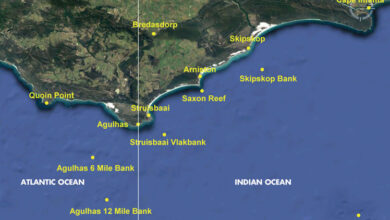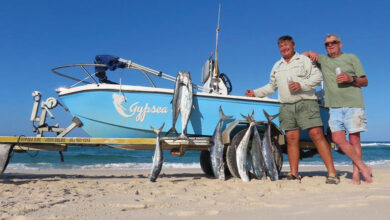Icelandic Escpades
Team SA at the EFSA European Boat Championships

(Published in the September/October 2018 issue of Ski-Boat)
By John Luef
THE air was electric with excitement on the day the South African bottomfish team fishing in the European Federation of Sea Anglers (EFSA) European Boat Championships in Iceland was announced. “Iceland, here we come!”
For team captain Martin Gierz, Daniel Hughes, Allen Ford, Rory Leonard and me, the unbelievable experience was about to become reality. Once the initial excitement was over, planning and preparations began immediately with internet searches for target species, tackle requirements, conditions, etc. The booking of flights, accommodation and practice fishing days as well as visa applications all happened fairly quickly.
Friends and family asked what conditions we could expect in Iceland during the last week of May and whether we would have to cut holes in the ice to fish. We laughed, but that’s probably most people’s impression of fishing so far north. Iceland is, in fact, a small country situated in the North Atlantic Ocean, north of the UK and not far from Greenland. It measures about 103 000km2 and has a population of just over 336 000 people. Most of them live in and around the capital, Reykjavik, in the south of Iceland. Iceland has numerous fjords all around the country with an abundance of fish of various species which we would later catch on our trip.
The team landed in Reykjavik in relatively good spirits just after 3pm on Monday 21 May after four flights and 27 hours of travelling. We collected our hire vehicle and set off on the eight hour drive to Sudavik where we had booked a number of practice fishing days. The competition venue was actually in Olafsvik, but due to a shortage of boats we could not get more than one practice day at the competition venue so had to opt for Plan B.
What an experience the drive was. Iceland is a stunning country characterised by sand, ancient lava fields, mountains, glaciers and many glacial river flows with stunning waterfalls. Also, in the so-called Icelandic summer, the sun shines approximately 22 hours a day and we arrived at our venue at 2am in bright sunshine. With a practice session arranged in a few hours’ time, the team immediately got busy unpacking and catching some shut-eye.
Our first practice day was a huge eye opener with regard to the weather conditions we were going to have to contend with. They included 40km/h wind, rain and a wind chill factor of about -6 degrees! We were all dressed warmly, but our hands froze up so badly that it was extremely difficult to bait hooks and impossible to try to tie knots. Our ears were so cold that the pain was almost unbearable. When we got off the water our first stop was a local supermarket where we made a serious dent in their stocks of thick woollen beanies and skiing gloves.
Over the next three practice days we experienced some awesome fishing, with the entire team landing various target species included in the competition, and all of us catching cod way over 10kg, with the biggest being around 18kg. Cod are extremely abundant in Iceland and are found in large schools from within the shallow fjords to deep sea. They are ferocious feeders and would take almost anything presented to them including but not limited to baited hooks, feathers, paddle tails, jigs and gummy macs (basically a large twisted hook with a coloured plastic coating).
Cod are also the main targets of the commercial boats which go out for a few hours a day, one man up and use multi-hook mechanical winches to catch large loads of cod. There are quite a number of these boats throughout Iceland, but they are limited to fishing only 14 days a month and also have total seasonal bag limits.
Another main target species for us was coalfish which we also took on a large variety of baits. They are very aggressive fighters but are much less abundant than cod. Wolffish was another of our targets. They are very similar to moray eels but are also fairly abundant in the shallow waters and are particular fond of a nice colourful skirt or beaded hook with a chunk of bait on it.
We also caught some flat fish very similar to sole called long rough dabs and flounders. These flat fish were only found in very shallow, sandy-bottomed areas and were extremely fussy, only taking on very small baited hooks that were rigged with colourful beads and fluorescent tubing.
Red fish — very similar to our Jaco Pever — were caught in deep water up to 100 metres on various baited hooks as well as feathers and luminous beaded hooks. Haddock seemed to like ’cuda-type baited skirts and jigs.
Other less common target species were ling, halibut, whiting, tusk, megrim and sculpin.
Our three practice days at Sudavik were most enjoyable, and on the Friday morning the team left confidently for the competition venue. We travelled through a long mountain tunnel and then over mountains and glaciers to get to a very small place called Hagi; from there we would take a ferry across a large fjord to a small town called Stykkisholmur and then had a short drive to Olafsvik. The scenery along the route and on the ferry was once again breath-taking and we stopped a few times to admire and photograph waterfalls, glaciers and mountains. At Hagi we had an unforgettable experience as we found a natural hot spring (Hot Pot) right on the rocks at the sea and all had a dip in the pool sipping on an ice cold local beer with snow capped mountains a few hundred metres away. When we eventually got out we literally froze.
Finally we reached Olafsvik, a really beautiful little town on the side of a mountain overlooking the harbour and sea; it has a population of about 900.
We had one more practice day arranged for the Saturday, and that went off really well, with some nice fish being caught. All that remained was to prepare all our traces and tackle, decide what traces would be used for what species of fish, and what the best time and areas would be to target these fish.
The opening ceremony march took place on the Sunday and was followed by the opening gala and final instructions to all the anglers. This was an emotional event as the reality of our situation finally sank in — we were marching with our country’s flag and representing our country at the highest level. The final count was 134 anglers participating, with 20 teams from 14 countries.
The final instructions were disappointing in that fishing time per day was cut to five hours and there would be two shifts per day due to a shortage of boats. Some of us were on the morning shift from 7am to 12 noon and the rest on the afternoon shift from 2pm to 7pm. The Tuesday was an absolute blow out, so in the end there would only be three five-hour fishing sessions.
The scoring system used in the championships is fair and gives everyone an equal chance. Anglers are split up onto various boats and for that day you only compete against the other anglers on your boat. Points are awarded for the first ten fish of each species caught by each angler, with the rarer species earning higher points. Bonus points are awarded for each species caught.
At the end of the day the points are tallied up and the angler with the most points on the boat earns 100%. All the other anglers then earn a percentage proportional to their points compared to the boat winner’s points. At the end of the tournament, your percentages are added up and that determines the individual results. All team anglers’ points are then added up after discarding the worst score each day, giving us the team results.
Needless to say, the competition was tough, extremely competitive and also very close, in that one fish here or there made a huge impact on your final score and the eventual team scores.
The competition flew by with our team having very little time to relax, because respooling of line and tackle and trace preparation took up huge amounts of time. The SA team was the only team that used the traditional South African deep sea Scarborough reels which we were comfortable with. By the end of the competition a lot of our opposition wanted to buy what they called our “large fly reels”.
Our team eventually finished a respectable 11th out of the 20 teams, beating some of the more experienced teams. This result was disappointing for us as we’d had much higher expectations, but unfortunately it wasn’t to be. As one of our team members put it, “It is what it is!” Norway A, Scotland A and Germany took the top three spots respectively.
The competition was finally over. Our team had fished seven of the last nine days but we hadn’t yet had enough and tried to book a charter on our last day before the prize giving ceremony. Sadly all the skippers were tired and refused to accommodate us, so instead we enjoyed a day off to do some shopping for souvenirs. The local currency is Icelandic krone and the exchange rate was eight krone to the rand. Everything in Iceland is extremely expensive by South African standards; a loaf of bread costs about R40, a 500ml bottle of still water R45, and a beer R100. Eating out was almost unaffordable as we found out at a pizza restaurant one evening where pizzas were on special at around R450 for a medium one! On our final evening we decided to visit the bottle store to have a well-earned drink, only to find that a bottle of Spiced Gold was priced at around R1 000. One of our team members quickly announced that it was still a bargain, so we bought it.
Our experience of a lifetime was finally over as we headed to the airport the next day, once again enjoying the beautiful scenery on the way and knowing we all had fantastic memories to cherish for the rest of our lives. Would we ever visit Iceland again? Absolutely, without hesitation!





